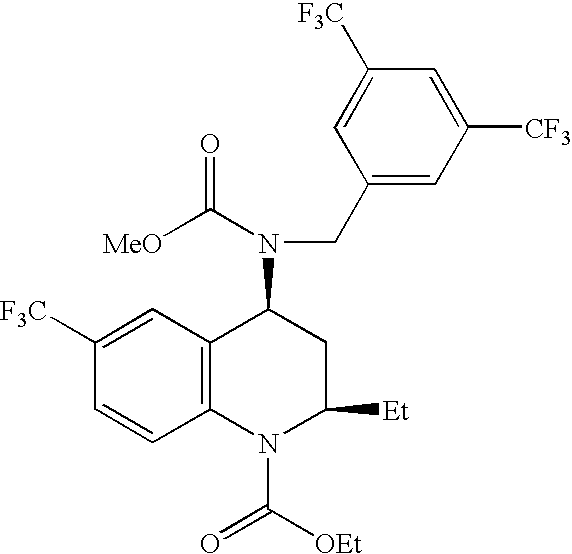Solid Adsorbates of Hydrophobic Drugs
- Summary
- Abstract
- Description
- Claims
- Application Information
AI Technical Summary
Benefits of technology
Problems solved by technology
Method used
Image
Examples
example 1
Formation of Solid Self-Emulsifying Hydrophobic Drug Composition
[0103]A liquid self-emulsifying composition was prepared by first forming a lipophilic vehicle containing 20 wt % Miglyol® 812 N (a 56% caprylic and 36% capric trialkyl glyceride, available from Condea Vista Inc.), 30 wt % triacetin, 20 wt % of the polyoxyethylene sorbitan fatty acid ester (Tween® 80), and 30 wt % Capmul® MCM (mono- and di-alkyl glycerides of capric and caprylic acid, available from Abitec Corp.). Next, to 7.0 mL of this lipophilic vehicle was added 3.03 g of the lipophilic drug [2R,4S]4-[(3,5-bis-trifluoromethyl-benzyl)-methoxycarbonyl-amino]-2-ethyl-6-trifluoromethyl-3,4-dihydro-2H-quinoline-1-carboxylic acid ethyl ester, also known as torcetrapib. The resulting suspension was stirred at 600 rpm for 7 hours, then centrifuged for 5 min at 13,000 G to separate undissolved drug. The supernatant was recovered and then diluted 1:1 (vol:vol) with methanol.
[0104]To form the solid self-emulsifying formulation...
examples 2-7
[0110]The solid compositions of Examples 2-7 were made as described for Example 1, varying the composition of the lipophilic vehicle, the amount of methanol, and the type of solid substrate, as shown in Table 3. In all cases, 8 mL of the methanol-diluted drug / lipophilic vehicle solution was added to 1 gm of the porous substrate, and the resulting slurry placed in a vacuum desiccator overnight to form a flowable powder. The potencies of the compositions of Examples 2-7 were determined as described in Example 1.
TABLE 3Ratio ofMethanolto Drug / Lipophilic VehicleLipophilicExam-CompositionVehiclePotencyple(wt %)(vol:vol)Solid Substrate(wt %)120% Miglyol,1:1Calcium silicate1530% Triacetin,(Zeopharm 600)20% Tween 80,30% Capmul MCM220% Miglyol,1:1Calcium silicate1130% Triacetin,(Zeopharm 600)20% Tween 80,30% Capmul MCM320% Miglyol,2:5Calcium silicate1130% Triacetin,(Zeopharm 600)20% Tween 80,30% Capmul MCM420% Miglyol, 3:10Calcium silicate1130% Triacetin,(Zeopharm 600)20% Tween 80,30% Capmul...
example 8
[0114]A liquid self-emulsifying composition was prepared by first forming a lipophilic vehicle containing 20 wt % Miglyol® 812 N, 30 wt % triacetin, 20 wt % Tween® 80, and 30 wt % Capmul® MCM. Next, to 7.0 mL of this lipophilic vehicle was added 3.0 g of the lipophilic drug torcetrapib. The resulting suspension was stirred at 600 rpm for 7 hours, then centrifuged for 5 min at 13,000 G to separate undissolved drug.
[0115]To form the solid self-emulsifying composition, the lipophilic vehicle / torcetrapib solution was added drop-wise to 0.5 g dried calcium silicate (Zeopharm® 600) while mixing with a spatula. A total of 1.4 mL solution was added to 0.5 g Zeopharm®, resulting in a free-flowing powder. Adding additional solution resulted in the formation of a sticky material that had poor flow characteristics. The solid composition was placed in a vacuum desiccator overnight.
[0116]The potency of the composition of Example 8 was determined using the procedures described for Example 1 to be ...
PUM
| Property | Measurement | Unit |
|---|---|---|
| Electrical conductance | aaaaa | aaaaa |
| Fraction | aaaaa | aaaaa |
| Fraction | aaaaa | aaaaa |
Abstract
Description
Claims
Application Information
 Login to View More
Login to View More - R&D
- Intellectual Property
- Life Sciences
- Materials
- Tech Scout
- Unparalleled Data Quality
- Higher Quality Content
- 60% Fewer Hallucinations
Browse by: Latest US Patents, China's latest patents, Technical Efficacy Thesaurus, Application Domain, Technology Topic, Popular Technical Reports.
© 2025 PatSnap. All rights reserved.Legal|Privacy policy|Modern Slavery Act Transparency Statement|Sitemap|About US| Contact US: help@patsnap.com

